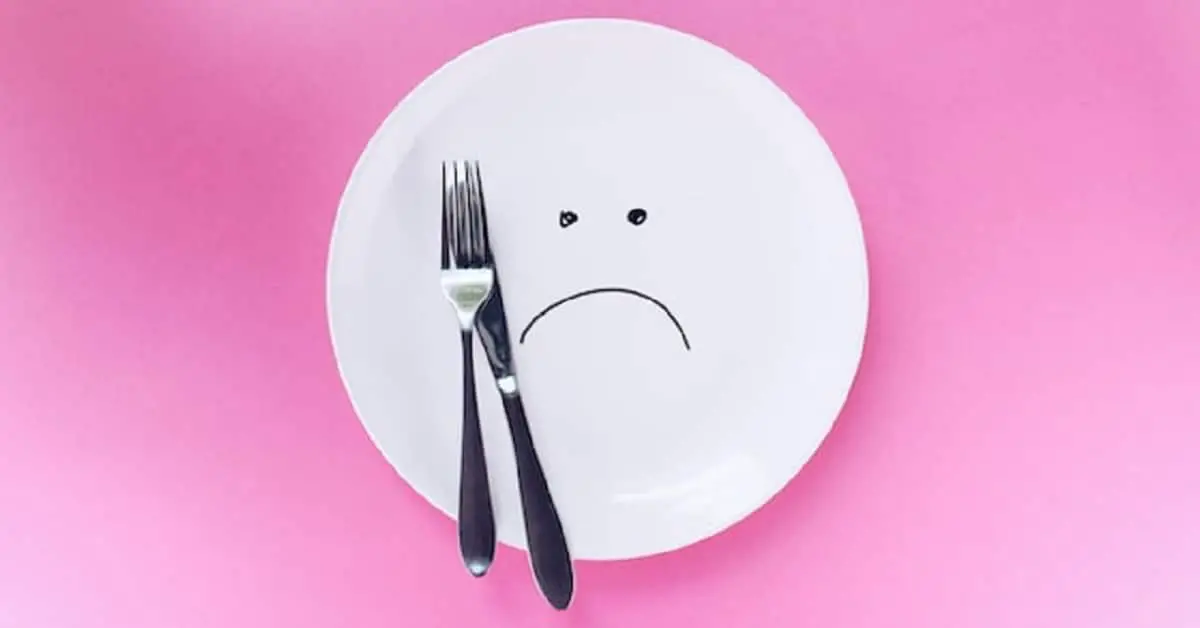
Orthorexia (orthorexia nervosa) is an obsessive preoccupation with healthy eating that inspires maladaptive behavior disruptive of well-being and overall quality of life.
At CARE healthy living, we share the principles of healthy eating with our readers. These principles are based on the results of scientific research intended to improve well-being.
Most people are familiar with the basics of healthy eating. We know it is healthy to focus on increasing our consumption of unprocessed cereals, whole grains, nuts, seeds, and legumes. We know that green leafy vegetables and fruits are healthy because they are rich in fiber, vitamins, and minerals.
Many also avoid processed foods with added sugars, fats (empty calories), and salt.
Most people attempt to follow these rules by examining food labels and paying attention to the quality of the components of their diet.
While it is entirely normal to be concerned about the health effects of one’s diet, people with orthorexia become so intensely fixated on observing the dos and don’ts of healthy eating that it negatively impacts the quality of their lives.
If you are concerned about the healthy eating preoccupations of a family member or wondering whether your concerns about healthful eating have developed into an unhealthy obsession, this article is for you.
We explore questions about orthorexia and what happens when healthy eating behavior turns into actions that endanger your health.
Contents
11 warning signs of orthorexia
- Preoccupation with nutrition
- Obsessive calorie counting
- Unhealthy dietary restrictions
- Excessive supplementation
- Preoccupation with dos and don’ts
- Preoccupation with the correct timing of meals
- Obsessive cleansing rituals (aka “detoxification”)
- Fixation on the threat of food toxins
- Orthorexics often attempt to impose their beliefs on others
- When healthy eating preoccupation assumes a moralistic tone
- Social and mental health problems due to healthy eating obsession
What is orthorexia nervosa?

The physician Steven Bratman coined the term orthorexia nervosa in 1997 to describe an unhealthy obsession with healthy eating and food quality (Dunn and Bratman, 2016).
[Fun fact: Orthorexia is from Greek words that mean “proper or correct eating”]
According to Dun and Bratman (2016), orthorexia is an obsessed preoccupation with healthy eating that leads to behavior disruptive of mental, social, and physical health.
It may manifest ins some patients as malnutrition and underweight.
Despite the growing recognition of the significance of orthorexia, the Diagnostic and Statistical Manual of Mental Disorders (DSM-V) has not formally recognized orthorexia alongside eating disorders, such as anorexia nervosa and bulimia.
Cena and associates (2019) reported that there was no consensus on a definition of orthorexia and that diagnostic criteria were still being debated.
According to Novara and colleagues (2021), orthorexia involves excessive attention to diet, maladaptive behaviors, emotions, and beliefs about eating healthy food.
Koven and Abry (2015) reported that despite receiving little research attention, clinicians frequently observed orthorexia in their patients.
The authors also defined orthorexia as a pathological obsession with nutrition. The condition is associated with
- Restrictive diet
- Ritualized patterns of eating
- Rigid avoidance of foods believed to be unhealthy or impure
The behaviors associated with orthorexia are usually motivated by a desire to improve health, but instead, they lead to nutritional deficiencies, medical complications, and poor quality of life.
There are currently no formal diagnostic criteria for orthorexia (read about orthorexia diagnostic tests here). The National Eating Disorders Association reported there are currently no clinical treatments officially recommended for the condition.
Experts have so far not come up with a precise definition of orthorexia. There is no consensus on diagnostic criteria that helps therapists understand whether to treat it as a stand-alone condition, a type of other eating disorders, or a form of obsessive-compulsive disorder (OCD) (Strahler et al., 2018).
However, Koven and Abry (2015) noted that the signs and symptoms of orthorexia overlap significantly with other conditions, such as:
- Anorexia nervosa
- Obsessive-compulsive disorder (OCD)
- Obsessive-compulsive personality disorder (OCPD)
- Somatic symptom disorder
- Illness anxiety disorder (previously known as hypochondriasis)
- Psychotic spectrum disorders
Experts face several challenges in diagnosing orthorexia. For instance, it is often difficult to determine the point at which preoccupation with healthy eating becomes unhealthy or harmful.
Words such as “excessive, extreme, intense preoccupation, fixation” used to qualify the severity of the condition rely on the observer’s subjective assessment. Another person may well disagree with your judgment that a particular individual is, in fact, excessively preoccupied with nutrition.
Despite the diagnostic challenges, mental health experts agree that orthorexia involves noticeable behavioral patterns focused on a preoccupation with the quality of food and diet that impairs the ability to meet nutritional needs. The compulsive behavior also impair the individual’s social, physical, or mental health rather than enhance them as intended.
11 warning signs of orthorexia

We identify 11 patterns of behavior that should raise a red flag about healthy eating preoccupation.
The list of warning signs follows the proposals for diagnostic criteria by Bratman and Dunn (2016) and other researchers.
According to Bratman and Dunn, orthorexia is an obsessive preoccupation with healthy or “clean” eating. It also involves strong emotions (anxiety, guilt, shame, fear) that drive compulsive behavior, such as severe restriction of food choices.
Extreme restrictions and emotional issues may lead to physical and mental health problems. Patients may suffer from malnutrition, severe weight loss, health complications, and interpersonal relationship problems.
The signs and symptoms of orthorexia may or may not be associated with body image issues. In most cases, orthorexia starts as a reasonable desire to see improvements in health status. But the preoccupation intensifies gradually until healthy eating transforms into disordered and harmful behavior.
And despite the harmful effects of the obsessions, it is often difficult to convince the patient that they are on the wrong path and need help.
1. Preoccupation with nutrition
Orthorexics may spend a disproportionate amount of time scrutinizing food labels for nutrients and ingredients they believe boost health. They never tire of drawing up new dietary plans and calculating nutrient values vis-a-vis requirements.
They usually show an intense interest in nutrition and dedicate an inordinate proportion of their time poring over healthy eating blogs and social media handles for the latest tips.
An orthorexic may spend so much time researching healthy eating that it interferes with other daily activities and responsibilities.
2. Obsessive calorie counting

The calorie content of food is an aspect of nutritional quality, but it deserves a separate mention due to the belief that calorie restriction is healthy.
Some healthy eaters dedicate a disproportionate amount of time, resources, and effort to counting and restricting calorie intake.
Some individuals become so preoccupied with counting calories that they can’t enjoy a meal without having calculated the calories they would consume by eating the meal.
Calorie counting obsession often leads to severe dietary restrictions. Drastically cutting carbs and other energy sources may lead to calorie malnutrition.
3. Unhealthy dietary restrictions

Closely related to calorie counting obsession are eating behaviors involving severe restriction of the variety of foods in the healthy eater’s diet.
According to Cena and associates (2019), people with orthorexia impose dietary rules on themselves to promote health, but the measures often have detrimental consequences.
The orthorexic’s exaggerated focus on “dietary purity” may result in severely disordered eating behavior (Scarff, 2017).
Severe dietary restrictions are often due to the conviction that eating more of certain types of food or avoiding certain foods boosts healthspan and cures diseases.
Orthorexics are often preoccupied with fears about diseases associated with eating “unhealthy” foods.
Preoccupation with the health effects of food may manifest as strict veganism (Brytek-Matera, 2021), which increases the risk of vitamin B12 deficiency.
It may also lead to a severely restricted intake of carbs, protein, fats, salt, and animal foods, including dairy. Restriction means that the healthy eater’s diet consists of a limited selection of foods they consider healthy or “clean.”
Such dietary restrictions may backfire and lead to nutritional deficiency and illness.
Warnings about the health effects of fats may lead some to adopt diets deficient in the nutrient, resulting in malnutrition and associated health issues.
Others become so fixated on concerns about processed foods, carcinogenic artificial ingredients, and GMO that they constantly scrutinize food labels and insist on eating only “natural” foods, low-fat foods, organic food, grass-fed milk or beef, or vegan foods (Scarff, 2017).
Having become convinced that a particular food item is “healthy,” the healthy eater with orthorexia may adopt a diet that includes a disproportionate amount of the “clean” food item, resulting in an imbalanced diet.
News websites recently reported on a healthy eating blogger who followed a severely restricted diet that required eating 50 bananas daily.
A noticeable feature of unhealthy dietary restrictions is extreme rigidity concerning the choice of food. While most healthy eaters occasionally give in to indulgence without evincing distress, orthorexics may experience extreme emotional distress when they break their dietary rules.
Strict dietary restrictions may force orthorexics to avoid food prepared by others due to fear of unknowingly ingesting “unhealthy” foods.
Orthorexia sufferers may also avoid social situations (such as dining out), social events, meetings, or business trips out of fear of breaking their diet restrictions.
They will often insist on attending events or traveling with pre-prepared food.
4. Excessive supplementation

Some individuals with orthorexia worry endlessly that their meals are not supplying enough vitamins, minerals, fibers, or other nutrients essential for health.
The persistent fears lead to excessive supplementation that causes health issues. Orthorexics with supplementation obsession may overdose on vitamins and minerals, such as vitamins D, B12, iron, and omega fatty acids.
5. Preoccupation with dos and don’ts of eating and food preparation
Individuals with orthorexia may spend disproportionate time researching the best way to prepare and serve meals. The individual appears to family members and relatives excessively concerned about which method of preparation is healthiest or which ingredient is the best.
Healthy eaters with orthorexia may also rigidly observe procedures about cooking time and what foods may or may not be combined or eaten with others.
Some develop chewing rituals to ensure proper mastication of food for optimum digestion and absorption.
The orthorexic may accumulate an extensive recipe of healthy foods and spend hours precisely measuring food and drawing up elaborate meal plans.
Long hours spent planning and preparing meals may lead to neglect of other personal responsibilities.
6. Preoccupation with the correct timing of meals
There are several legitimate health reasons for observing the proper timing of meals.
Health experts recommend an early breakfast. They may also recommend avoiding snacks in between meals. Dietitians may advise people with digestive issues, prediabetics or diabetics who experience overnight sugar spikes to avoid taking heavy late-evening meals.
However, some people become obsessed with the timing of meals and go to extreme lengths to avoid breaking their self-assigned feeding schedule. The behavior of the healthy eater may seem compulsive to family members rather than informed by specific health-related concerns.
For instance, an orthorexic may develop the habit of eating a certain healthy food at a particular time of the day or drinking herbal tea before going to bed. They may refuse to bend the rules regardless of the circumstance and experience significant emotional distress or sleeplessness when unable to observe the daily ritual.
7. Obsessive cleansing rituals (aka “detoxification”)

In addition to food timing preoccupation, some healthy eaters develop elaborate cleansing or detoxification rituals. Such rituals may involve extreme fasting, ingesting antioxidant preparations, or consuming large quantities of liquid preparations believed to “flush out” the system, open the sweat pores, cleanse the kidneys, or detoxify the liver.
They rigidly observe the timing and performance of their cleansing rituals and may get upset if any other issue interferes with or breaks the schedule for their cleansing rituals.
8. Fixation on the threat of food toxins
Relatives may get the impression that a healthy eater appears obsessed with fears about things such as toxins and other harmful whatnots in their diet.
The orthorexic may spend hours researching possible toxic contaminants and how to avoid them. They consult websites to research food additives and may constantly worry about contaminants, such as pesticides and BPAs.
They may also be obsessed with fears about harmful artificial ingredients, such as preservatives and sweeteners, that the manufacturer may have secretly added to their food products.
9. Orthorexics often attempt to impose their beliefs on others
Healthy eaters with orthorexia may take more than a casual interest in other people’s eating habits. They may preach their beliefs and try to impose them on disapproving family members.
“Clean” eaters are likely to attempt imposing their views on disapproving family members. They zealously preach their healthy eating beliefs to relatives, friends, and strangers (Scarff, 2017)
They may deliver long haranguing lectures about bad foods, such as GMOs, fat cuts, and sweets, and tirelessly extol the virtuals of “good” low-fat foods, organic foods, keto diets, their favorite DASH plan, or latest carb cyling program.
10. When healthy eating preoccupation assumes a moralistic tone
For some people with orthorexia, healthy eating is an exercise of virtue characterized by a “healthier-than-thou” attitude.
Orthorexics may pass intemperate moral judgment on people who don’t live up to their stringent dietary standards.
A healthy eater with orthorexia who separates food into rigid categories of “good” and “bad” may appear to equate the consumption of foods categorized as “bad” with moral or spiritual defilement.
Such individuals may attach strong emotions to their choice of food and experience emotional distress (anxiety, anger, fear, guilt) over concerns about unintentionally ingesting unhealthy food.
They may also become convinced of their moral superiority over people who eat foods they consider to be unhealthy.
11. Social and mental health problems due to healthy eating obsession
Individuals obsessed with healthy eating are often motivated by morbid fears about their health and convictions that following a strict dietary regimen will stave off illness and lengthen their healthspan.
They may be fixated on fears that eating certain foods cause health problems.
However, their self-imposed dietary restrictions may prove difficult to sustain, resulting in a cycle of failures and renewal of effort that intensify anxiety and a sense of guilt.
While struggling to comply with their excessively restrictive dietary regimen, a single incidence of non-compliance that others would shrug off could lead to intense emotional distress, feelings of anxiety, depression, guilt, shame, anger, and stress.
It may also lead to conflicts with close family members who view the orthorexic’s healthy eating obsession as irrational and harmful.
Orthorexia risk factors
McCombs and Mills (2019) conducted a systematic review to assess the psychosocial risk factors associated with orthorexia nervosa (ON). They concluded that gender and self-esteem were unrelated to ON. However, they found that the following traits were positively associated with the condition:
- Perfectionism
- Obsessive-compulsive traits
- Psychopathology
- History of an eating disorder
- Dieting
- Poor body image, and
- Drive for thinness
Factors that were less positively associated with ON included:
- Age
- Body Mass Index (BMI)
- Working in a health-related field: Grammatikopoulou and colleagues (2018) reported that health sciences, nutrition, and dietetics students had an increased prevalence of Other Specified Feeding and Eating Disorders (OSFEDs), including stress-related eating, food addiction, and orthorexia (Yu and Tan, 2016; cf. Villa et al., 2022).
- Exercise engagement
- Vegetarianism/veganism: Brytek-Matera (2021) reported that following a vegetarian diet was positively correlated with orthorexic eating behaviors. However, Cicekoglu and Tuncay (2018) found no evidence of an association between veganism and obsession with healthy eating.
- Body dissatisfaction
- Alcohol, tobacco, and drug use.
According to Novara and associates (2021), the following are the risk factors for orthorexia:
- Dieting
- Obsessive-compulsive symptomatology,
- Perfectionistic traits
- Anxiety, depression, and low self-esteem (Yilmaz and Dundar, 2022)
- Body Mass Index [BMI]) were investigated in all groups.
Orthorexia diagnostic tests

Several researchers have proposed screening tools for identifying, evaluating, diagnosing, and assessing the prevalence of orthorexia or orthorexic behaviors.
According to Niedzielski and Kazmierczak-Wojtas (2021), the following are some of the better-known proposed screening tools (Meule et al., 2020).
- Orthorexia self-test-BOT: The self-test designed by Bratman consists of ten questions you answer “yes” or “no.” The questions help detect signs and symptoms of orthorexia (Valente et al., 2019). You may take the orthorexia self-test-BOT here.
- ORTO-15 questionnaire: The ORTO-15 is a screening tool based on Bratman’s orthorexia self-test and MMPI obsessive-phobic personality trait questions (Varga et al., 2014). The self-report questionnaire consists of 15 multiple-choice questions. Many researchers have investigated the validity of the questionnaire, and some have questioned its reliability (Stochel et al., 2015; Heiss et al., 2019; Niedzielski and Kazmierczak-Wojtas, 2021; Mitrofanoa et al., 2021; Gonidakis et al., 2021). You may view the test here (in English and Spanish) or here.
- ORTO-R test is a revised version of ORT0-15 proposed by Rogoza and Donini in 2021.
- Eating Habits Questionnaire-EHQ is also a self-report screening tool with 21 items (Halim et al., 2020). The tool evaluates responses in three categories: (1) Knowledge of healthy eating. (2) Problems associated with healthy eating. (3) Positive feelings about healthy eating. It assesses responses on a four-point scale (false-1 point, slightly true-2 points, mainly true-3 points, and very true-4 points). The higher the sum of the respondent’s score, the higher the likelihood of orthorexic tendencies.
Other tests include:
- Düsseldorf Orthorexia Scale-DOS
- Teruel Orthorexia Scale-TOS,
- Barcelona Orthorexia Scale-BOS, and
- Orthorexia Nervosa Inventory-ONI
Niedzielski and Kaźmierczak-Wojtaś (2021) noted that there was no reliable data on the prevalence of orthorexia nervosa and that estimates depended on criteria proposed by the different screening tools.
They concluded that the reliability of some screening tools–such as the ORTO-15 questionnaire–was questionable due to the high percentage of falsely positive results.
Orthorexia treatment
As previously mentioned, there are currently no formal diagnostic criteria for orthorexia. There are also no official guidelines for the treatment of orthorexia.
However, the National Eating Disorders Association noted that current treatments usually involve psychotherapy to help the patient increase the variety of foods they eat.
Because many orthorexia patients consider their eating behavior healthy and appropriate, therapists face the challenge of convincing patients that they have a problem and need help.
However, treatment becomes easier once the patient recognizes that their eating habits are negatively impacting their lives and that there is a need for change.
Treatment involves physicians, psychologists, and nutritionists (dietitians).
Therapists may adopt several approaches, including:
- Cognitive reframing helps patients identify maladaptive patterns of thought and behavior
- Behavior modification
- Psychological therapy may involve exposing the patient to the foods they avoid eating to desensitize them and reduce fear or anxiety experienced in the presence of such foods.
In cases of weight loss or malnutrition, a dietitian helps the patient improve nutrition and regain body weight. The dietitian helps the patient correct mistaken and harmful notions about healthy eating.

